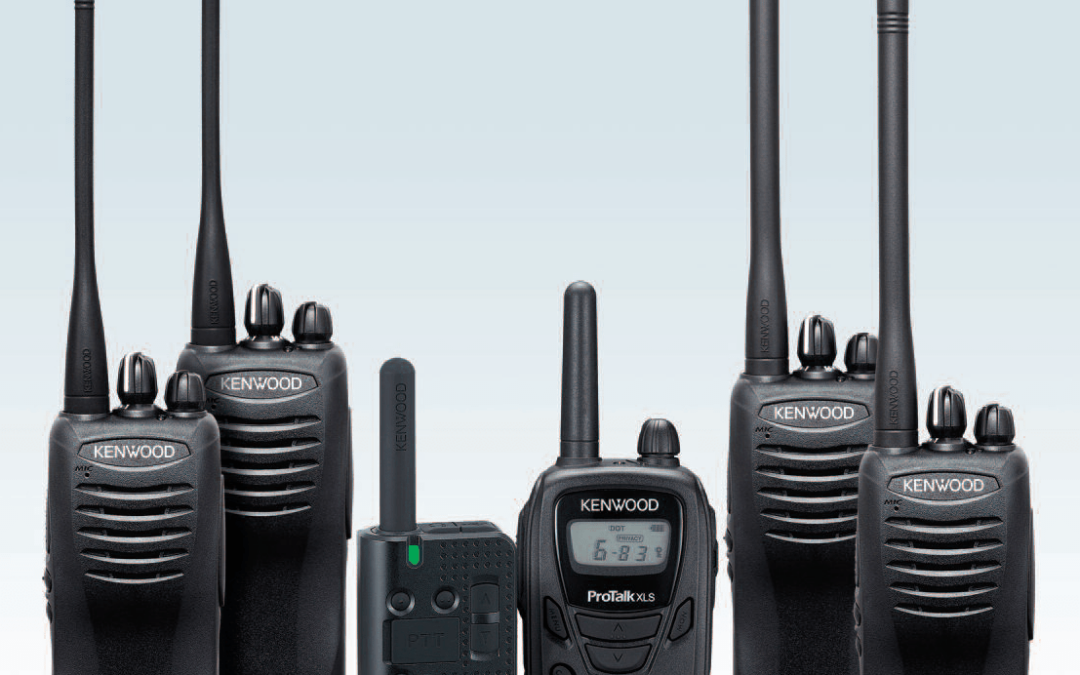It is common for people to choose a product based on marketing claims or to test them under questionable conditions. YouTube is full of people testing walkie-talkies in their cars, often with different antennas on each, invalidating the test results. I have seen some videos where the person claims that one radio sounds clearer than the other when I can’t hear a difference. Some manufactures or vendors will pad numbers to make their specs look better. To avoid subjective tests or fabricated numbers, there is a standard set of specifications that can be tested with the proper equipment.
Range
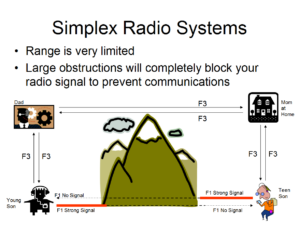
“Range” is not a specification for a radio; it is a marketing ploy. While the range of a radio may be affected by the transmit power and receiver sensitivity, it is far more affected by line of sight. If the range of a radio is printed on the package or in the specifications, beware. To start with, the claim is always qualified with small print saying “up to”. This means it has to be ideal conditions with no obstructions. What limits the range of the radio has more to do with buildings, mountains, and the curve of the earth. Terms like “long range” don’t really have a definition and are generally used to sell the customer on spending more on a “better model”. Similarly, “sounds great” is not a valid test result or specification.
Duty Cycle – Percentage transmit time
A duty cycle in a two-way radio transmitter refers to the fraction or percentage of one period in which a signal or system is active. It is a critical measurement in determining how much a radio transmitter is being used. For example, a duty cycle of 20% indicates that the transmitter is active 20% of the time and idle for the other 80%. The duty cycle plays a significant role in the efficiency of the transmitter and helps avoid overheating, as too high a duty cycle can cause excessive heat and potentially damage the transmitter. Therefore, understanding and managing the duty cycle is crucial in maintaining the longevity and effectiveness of a two-way radio transmitter.
Bandwidth
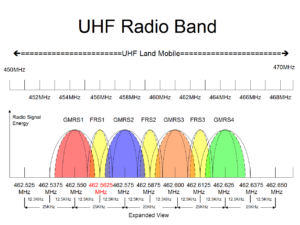
Bandwidth on two-way radios refers to the range of frequencies that the radio operates on. It is typically measured in kilohertz (kHz) or megahertz (MHz). The width of the bandwidth determines the amount of data that can be transmitted over a certain period of time. For instance, a narrowband radio might have a bandwidth of 12.5 kHz, while a wideband radio might have a bandwidth of 25 kHz. A very narrowband radio would have a bandwidth of 6.25 kHz. The wider the bandwidth, the more data can be transmitted, leading to clearer and more detailed communication. However, wider bandwidths also require more power and can cause more interference with other signals. Using a narrower bandwidth can get more range for a given amount of power (watts). Therefore, the choice of bandwidth depends on the specific requirements of the communication system. For two-way radios used in professional or emergency services contexts, the Federal Communications Commission (FCC) in the U.S. has mandated the use of narrowband channels to conserve spectrum space.
Output Power
Two-way radio transmit power refers to the level of power, measured in watts, that is used to send a radio transmission. Increasing wattage generally increases the range of a two-way radio, but not as much as people think. This is because a stronger signal can travel further before it becomes too weak to be received clearly. For instance, a 5-watt radio typically has a greater range than a 1-watt radio. However, the terrain and other potential obstructions like buildings can also significantly influence the actual range. S-units, or signal units, are a measure of the strength of a received signal at the receiving end. Each S-unit represents a relative increase in signal strength of 1 s-unit per 6 dB (4x the power). Typically, a portable radio (walkie talkie) is 5 watts. There are some with a higher wattage, but there are drawbacks. Higher wattage portables will drain the power faster, and some manufacturers are claiming power levels over 10 watts, which could be dangerous. Some low end manufactures are claiming power levels that the radio won’t actually do, and some vendors are padding the specs.
Spurious Emissions
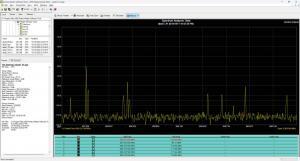
Spurious emissions are unwanted frequency signals that are generated by two-way radio transmitters, which can interfere with other communication devices. These unintentional signals are the byproducts of complex electro-physical processes within the transmitters. They are not only a waste of power but can also cause harmful interference to other communication services. To control this, the Federal Communications Commission (FCC) has set a legal limit for spurious emissions.
(1) On any frequency removed from the assigned by more than 50 percent, but not more than 150 percent of the authorized bandwidth: At least 25 dB.
(2) On any frequency removed from the assigned frequency by more than 150 percent, but not more than 250 percent of the authorized bandwidth: At least 35 dB.
(3) On any frequency removed from the by more than 250 percent of the authorized bandwidth: At least 43 + 10 log P dB. P is the power in watts
This is important because part of the success of communication systems is the cooperation of everyone in sharing the spectrum. Not doing so contributes to RF noise pollution.
Frequency Stability
Frequency stability refers to the ability of a two-way radio to maintain its assigned frequency during operation. It’s a measure of the consistency and reliability of the radio’s signal and is typically expressed in parts per million (ppm). A lower ppm value indicates higher frequency stability and better performance. The frequency stability of a two-way radio is influenced by several factors including temperature changes, power supply variations, and aging of the device. For instance, extreme temperatures can cause the radio’s oscillator to drift off frequency, affecting the clarity and range of communication. In terms of specifications, manufacturers often provide a frequency stability rating that states the maximum expected frequency deviation under specified conditions. For example, a typical specification might indicate a stability of ± 2.5 ppm over a temperature range of -30 to +60 degrees Celsius. This means that the actual transmit frequency should never deviate more than 2.5 Hz for every 1 MHz of carrier frequency, throughout the specified temperature range. Drifting off frequency can cause distortion of your signal and interference to others.
Frequency Range
This is the frequency range that the radio is designed to operate in. There will be a minimum and maximum frequency listed. In some cases there may be ranges in more than one band, or different ranges listed for transmit and receive. This range designates what the radio is designed to cover, but not what is legal for you to use. Many bands require licenses for use. Modification of the radio to cover frequencies outside it’s design may also be illegal as well as possibly resulting in spurious transmissions or damage to the radio.
Operating Temperature
The operating temperature limit of a two-way radio typically ranges between -22°F and 140°F. This range indicates the minimum and maximum temperatures at which the device can function optimally without any hindrance or damage. If a two-way radio is operated below or above these temperature limits, it may not work correctly or could even suffer permanent damage. For instance, excessively low temperatures can cause the battery to drain quickly or even freeze, while extremely high temperatures can cause overheating. It’s important to note that these values can vary slightly depending on the specific brand or model of the radio.
Sensitivity
The sensitivity of a two-way radio is a crucial aspect of its performance, as it determines the strength of a signal the radio requires to provide a clear, intelligible audio output. It is commonly measured using two key parameters – SINAD (Signal-plus-noise-plus-distortion) and BER (Bit Error Rate). SINAD is a ratio that combines the desired signal, unwanted noise, and distortion elements to establish the minimum signal level necessary for acceptable audio quality. A typical value for a two-way radio might be 12dB SINAD, corresponding to around 0.2 to 0.3 uV. BER, on the other hand, is a digital concept and it quantifies the number of bits received incorrectly compared to the total number of bits transmitted. In terms of dBm (a power ratio in decibels of the measured power referenced to one milliwatt), a typical value for good sensitivity would be around -116 to -120 dBm.
Selectivity
Two-way radios are designed with the ability to filter out signals or conversations from other channels. This feature, known as selectivity, is critical for minimizing interference and ensuring clarity of communication. The selectivity of a two-way radio is typically measured in kilohertz (kHz)/decibels (dB), with a higher dB value indicating better selectivity. For instance, a typical two-way radio might have a selectivity rating of 70-80 dB for adjacent channel rejection. This means that the radio can effectively reduce signals from adjacent channels by 70-80 dB, thereby ensuring clear and interference-free communication. This is one of the areas where cheap radios often fail.
Typical Values:
12.5 KHz 65dB
25 kHz 72 dB
Intermodulation
Intermodulation specification, also known as intermodulation distortion (IMD) spec, is a vital aspect of a two-way radio. It refers to the creation of additional frequencies that are not present in the original signals due to the mixing of two or more signals in a device, such as a transmitter, amplifier or receiver. In two-way radios, IMD is a significant contributor to interference that can degrade the quality of communication. The typical values of IMD for a two-way radio may vary depending on the individual design and the complexity of the device. However, in many cases, an IMD spec of 35dB to 60dB is considered acceptable, although higher values are desired for improved performance. This is another spec that cheap radios often have trouble with. Often the user will be puzzled when they put a better antenna on and the performance gets worse.
Spurious Rejection
Spurious Rejection specification of a two-way radio refers to the radio’s ability to ignore unwanted signals or frequencies that are not on its programmed channel, also known as spurious signals. The radio’s receiver is designed to reject these signals, and the effectiveness of this function is measured in decibels (dB). A higher Spurious Rejection spec indicates a better performance. Typical Spurious Rejection values for two-way radios range between 70 to 80 dB. This specification is crucial as it ensures clear communication by minimizing the chances of unwanted signals interfering with the communication channel.
Audio Output
This pertains to the speaker’s audio output. While a two-way radio doesn’t require as much power as a traditional stereo system, a higher output proves beneficial in loud surroundings or when the radio’s location isn’t ideal.
Power Supply
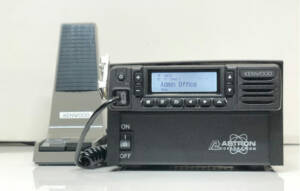
Typically, an operating voltage and maximum current are specified. The actual current varies based on the radio settings, with the transmission drawing significantly more current than the reception, contingent on the transmission power.
Battery Capacity
The battery capacity is typically measured in milliampere-hours (mAh) or ampere-hours (Ah). These are units of electric charge, and they represent the amount of energy that a battery can store. A battery with a higher mAh or Ah rating would generally last longer than a battery with a lower rating, assuming that the two batteries are subjected to the same usage patterns. The mAh represents one thousandth of an Ah, so 1Ah = 1000mAh. To calculate the battery run time, you need to know the battery capacity (in mAh or Ah) and the current consumption of the device (in amps).
FCC ID
The FCC ID number on two-way radios is a unique identifier assigned by the Federal Communications Commission (FCC) in the United States. This number is used to certify that the device complies with specific regulations governing radio frequency and signal strength. The FCC ID is crucial for two-way radios because these devices use designated frequencies and must adhere to set standards to ensure they do not interfere with other systems or services. Without an FCC ID, a two-way radio is not legally approved for use in the United States with the exception of Amateur Radios, which are allowed to be modified by a licensed amateur radio operator. This is a typical FCC ID, which can be used to look up the test results and certifications of the radio. One note, some low-end radios may have labels with a forged ID, or may have redesigned the radio after the initial testing was done. Looking up the ID can help determine if the radio is actually compliant.
How to test
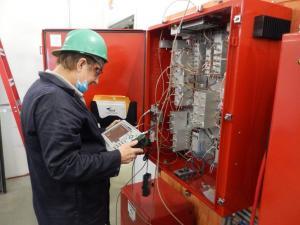
The specs are published by the manufactures, they will usually be correct if the radios if from one of the more reputable companies. . There is the problem of low end manufacturers misrepresenting them though. You can look up the test results using the FCC ID, which will be more likely to be accurate, though in some cases the tests have been done on a sample radio and the specs changed on the production run either due to substitution. To be sure, it is best to call a radio shop that can do the test, or perhaps may have already tested the radio you are considering.
